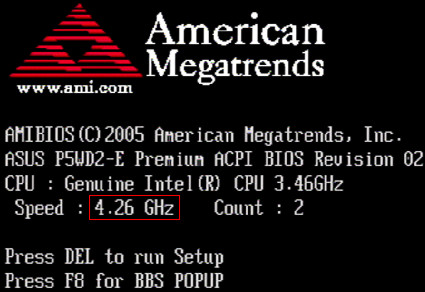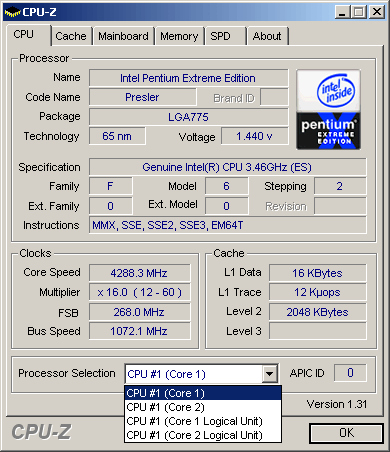Intel's 65 nm Process Breathes Fire into Double-Core Extreme Edition
Overclocking To 4.26 GHz
We could boot the system at 4.26 GHz, but the voltage had to be increased to 1.40 V in order to make the setting stable.
Running a multiplier of x16 allows for hitting an amazing 4.26 GHz, which is a 23% increase over the default clock speed of 3.46 GHz. At this speed, the double-core Pentium becomes noticeable warmer, but it still does not dissipate the heat levels of a 90 nm dual core Pentium D or Pentium Extreme Edition 840.
We don't believe that a 4 GHz-dual core device will be available any time soon, but Intel certainly can release a Pentium Extreme Edition 965 at 3.73 GHz. However, we don't believe that such a small speed upgrade would deliver much better system performance, since it only represents a < 8% clock speed increase.
Voilá: Raising the core voltage from 1.30 to 1.40 V allowed the Pentium Extreme Edition 955 to hit the 4.26- GHz mark.
No Energy-Saving Features
There is one disadvantage that the Extreme Edition processors suffer from: They do not support SpeedStep. The reason is very simple: SpeedStep has been based on reducing the multiplier on-the-fly to x14, resulting in a 2.8- GHz SpeedStep clock speed. Since the Extreme Editions run at a 266 rather than a 200 MHz FSB speed, there is no way to perform this very same action. Future SpeedStep generations will require a specification update.
Get Tom's Hardware's best news and in-depth reviews, straight to your inbox.
Current page: Overclocking To 4.26 GHz
Prev Page Overclocking To 3.73 And 4.0 GHz Next Page Updated Benchmark Suite
Patrick Schmid was the editor-in-chief for Tom's Hardware from 2005 to 2006. He wrote numerous articles on a wide range of hardware topics, including storage, CPUs, and system builds.

